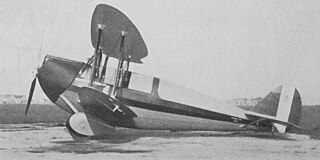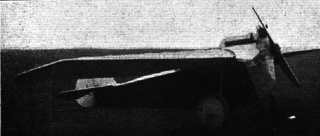The Koolhoven F.K.42 was a parasol-wing, two-seat training monoplane manufactured by Koolhoven in the Netherlands. Only one was built.
The Parnall Parasol was an experimental parasol winged aircraft design to measure the aerodynamic forces on wings in flight. Two were built and flown in the early 1930s in the UK.

The Junkers T 19, originally known as the J 19, was a single-engined parasol winged all-metal 2/3-seat aircraft built in Germany in the early 1920s for training and touring. Its construction was too expensive for commercial success and only three were built, one later finding use as an engine test-bed.
The Junkers T 23 was a two-seat, single-engined experimental training aircraft, built in Germany in the early 1920s. It could be configured either as a parasol winged monoplane or as a biplane to compare handling characteristics. 4 were constructed.

The Morane-Saulnier MS.341 was a single engine parasol wing training and touring aircraft built in France in the mid-1930s. It had two open cockpits in tandem and was sold to private owners, clubs and the Armée de l'Air.

The Caproni Ca.125 was a single-engine, tandem two-seat, touring biplane built in Italy in 1933. It could be operated either as a landplane or seaplane.

The Carley C.12 was a small Dutch single seat sporting monoplane from the 1920s. There were several developments but only small numbers were produced.

The Pander D was a small Dutch single-seat sport monoplane, an evolution of the Carley C.12 of 1923. Ten were built.

The Pander E was the first indigenous Dutch training aircraft, used by clubs and also privately owned. A two-seat, single-engine biplane, 17 were built in the Netherlands from 1926 with engines of increasing power.
The Pander P-3 was a parasol wing, two seat, single engine sports aircraft designed in the Netherlands in the early 1930s. Only one was built.
The Pander Multipro was a two/three seat light monoplane aircraft with a high, braced wing, designed in the Netherlands in the early 1930s. Powered by a Pobjoy radial engine, three were built.

The Koolhoven F.K.47 was a 1930s one-off two seat biplane designed and built in the Netherlands for an individual customer as a sport and touring aircraft.
The Koolhoven F.K.44 was a two-seat, single engine sport monoplane designed and built in the Netherlands in the early 1930s. It was built to order, but only one was completed.

The Koolhoven F.K.54 was a Dutch single-engine, three-seat touring aircraft with a retractable undercarriage. It flew shortly before the start of World War II and its development was abandoned after its first flight as attention turned to military aircraft.
The NAVO RK-4/220 was a Dutch aircraft originally designed for unofficial crowd observation but which was completed as an airliner. Only one was built; it flew, but was never certified.
The Ruhrtaler Ru.3 was a German advanced single-seat trainer designed to take pilots to combat standards. Initial flying tests showed promise but the owner of Ruhrtaler cancelled all aeronautical activity after his son was killed whilst demonstrating the Ru.3 to the Air Ministry.

The SECM-Amiot 130 R.2 was a contender for a French government contract for a long range, two seat reconnaissance aircraft, issued in 1928. There were eight prototypes in the 1931–32 contest and the Amiot 130 was not selected for production.
The LKL IV and LKL V were a pair of very similar Polish parasol wing two-seaters, built in the early 1930s. They differed primarily in their engines.

The Sido S.1 was a Polish two seat, parasol wing trainer aircraft, first flown in 1930.
The Pacer Monoplane was a parasol wing, four seat, light aircraft, flown and produced in the US in the late 1920s.










